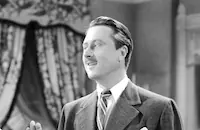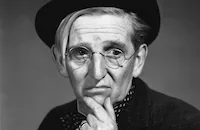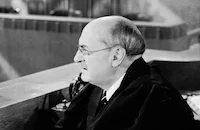The Shining Hour

Brief Synopsis
Cast & Crew
Frank Borzage
Joan Crawford
Margaret Sullavan
Melvyn Douglas
Robert Young
Fay Bainter
Film Details
Technical Specs

Synopsis
Henry Linden, a wealthy farmer from Wisconsin, has fallen in love with New York City nightclub entertainer Olivia Riley and wants to marry her. Although Olivia is not in love with Henry, she is lonely and fond of him, so she agrees to become his wife and move to his family's Wisconsin farm. Meanwhile, Henry's brother David, who has never met Olivia, goes to New York to try and stop the marriage, but when he sees her, he immediately becomes very attracted to her. She is also attracted to the moody David, but, for Henry's sake, neither express their feelings and she soon weds Henry. At the farm, David's wife Judy, a sweet, uncomplicated woman who loves her husband very much, is kind to Olivia, but Hannah, David and Henry's possessive older sister, is cold to her new sister-in-law. Hannah's feelings of animosity toward Olivia soon cause strains on the family, as does the growing attraction between David and Olivia. To alleviate the strain of living under the same roof with the rest of the family, Olivia and Henry build a new house close by. Building the new house seems to help Olivia, but soon David approaches her and tells her that he loves her. Olivia, who is still attracted to David, feels disloyal to Henry as well as to Judy, who has become her closest friend, and begins to think that she should leave. At a house-warming party for Olivia and Henry, Hannah makes snide, hurtful remarks to Olivia, and Benny Collins, a hired hand who is also attracted to Olivia, makes a pass at her and is knocked down by David. Later, Olivia tells Henry that she wants to leave and, though he does not completely know why, he agrees that they should travel for a while. When Henry goes to tell Hannah, she angrily accuses him of being blind to his wife's true character, and he tells her that it is she who is forcing them to leave. Just then, Benny rushes in to tell them that Henry and Olivia's new house is in flames. While the family tries to stop the fire, Judy, who has suspected that the more worldly David is in love with Olivia, rushes into the burning house. As the structure collapses, Olivia runs into the house and saves Judy. Though Olivia's burns are minor, Judy is very seriously burned in the blaze. Guilt-ridden over Judy's attempted sacrifice, David finally realizes that he has loved his wife all along. After Olivia tells him to go to her bedside, he finds Judy's face bandaged, but her eyes show him that she forgives him. Now realizing that she does not love David, Olivia decides that she must leave the farm and will not listen to Henry when he tries to convince her to stay. Hannah, however, whom Henry knows set the fire, tells her brother that she was wrong about Olivia and begs him to either bring her back or go with her. After listening to her advice, Henry goes after Olivia and they drive away from the farm together, in the hope of finding a new life.

Director

Frank Borzage
Cast

Joan Crawford

Margaret Sullavan

Melvyn Douglas

Robert Young

Fay Bainter

Allyn Joslyn

Hattie Mcdaniel
Oscar O'shea

Frank Albertson
Harry Barris
Tony De Marco
Claire Owen

Jimmy Conlin

Granville Bates
Roger Converse
Ralph Bushman

Frank Puglia
George Chandler
Buddy Messinger
Charles Coleman
Edwin Stanley

E. Allyn Warren
Grace Hayle
Jacques Vanaire
Cyril Ring

Bess Flowers
Grace Goodall
Jack Raymond
Sarah Edwards
Crew
Frank Borzage
Lew Borzage
Frédéric Chopin
Mr. De Marco
George Folsey
Cedric Gibbons
Paul Groesse
Frank E. Hull
Joseph L. Mankiewicz
Jane Murfin
Ogden Nash
Douglas Shearer
Dolly Tree
Franz Waxman
Edwin B. Willis

Photo Collections
Videos
Movie Clip



Trailer
Film Details
Technical Specs

Articles
The Shining Hour
Crawford was always on the lookout for plays which could be adapted for her to star in onscreen. When she saw the play The Shining Hour, she thought the story of a New York showgirl who marries a man from a conservative Midwestern family, and falls in love with her husband's married brother, would make a good Crawford vehicle. MGM head Louis B. Mayer agreed, but balked when Crawford asked for Fay Bainter to play the husband's domineering sister, and Margaret Sullavan for the role of the straying brother's loyal wife in the film version of The Shining Hour (1938). Mayer, ever protective of one of his favorite stars, warned Crawford that both women were experienced stage actresses, and could easily steal the film from her. (Bainter, in fact, would be nominated for two Academy Awards for films made the same year as The Shining Hour: as Best Actress for White Banners (1938), and Best Supporting Actress in Jezebel (1938), winning the latter.) But Crawford told her boss, "I'd rather be a supporting player in a good picture than the star of a bad one." All three women turned in excellent performances in The Shining Hour, with Crawford rising to the challenge presented by her co-stars. And all three responded to the sensitive direction of Frank Borzage, whose best films revolved around emotional, spiritual, and idealistic themes.
The Shining Hour was the third of four films Margaret Sullavan would make with Borzage. Three of them -- Little Man, What Now (1934), Three Comrades (1938), and The Mortal Storm (1940) -- dealt with the rise of Nazism in Europe. But The Shining Hour did have something in common with those films: Sullavan's character displayed the traits for which Borzage had such an affinity. How her character plays out her lofty ideals and self-sacrifice might seem ludicrous in any other hands, but Sullavan makes it poignant and believable. If Sullavan's luminous beauty was especially glowing in The Shining Hour, it could have been because she was pregnant with her first child. After brief, tumultuous marriages to Henry Fonda and director William Wyler, she seemed to have settled into happy domesticity with agent Leland Hayward. Their daughter Brooke would be born later that same year.
Crawford, seeing Sullavan's happiness, wanted the same. However, she had suffered several miscarriages, and her marriage to Franchot Tone was shaky. It came to an end during the filming of The Shining Hour when she caught him being unfaithful. But at Mayer's insistence, Crawford delayed suing for divorce until after the film opened. Soon after her divorce, Crawford adopted a baby girl, Christina, becoming the first major unwed star to adopt a child. Coincidentally, decades later both Brooke Hayward and Christina Crawford wrote tell-all books: Hayward's tragic family memoir, Haywire (1977), and Crawford's tale of child abuse, Mommie Dearest (1978).
Melvyn Douglas, who played Crawford's husband in The Shining Hour and co-starred in four films with her, was discreet in his own memoir. He merely said that Crawford "played as many parts off the stage as on....I am not sure that, for better or worse, she would have recognized the difference -- or even that there was a difference." During the filming of The Shining Hour, Douglas recalled, Crawford used language that "was not exactly sanitary," and she was "rough, bluff, and hearty."
In spite of the fine performances, critical and public response to The Shining Hour was lukewarm, and Crawford's career continued on a downhill slide. She made a few well-regarded films over the next several years, but the public mostly stayed away from Crawford movies. In 1943, by mutual consent, Joan Crawford and MGM ended their 18-year association.
Director: Frank Borzage
Producer: Joseph L. Mankiewicz
Screenplay: Jane Murfin & Ogden Nash, based on the play by Keith Winter
Cinematography: George Folsey
Editor: Frank E. Hull
Costume Design: Adrian
Music: Franz Waxman
Art Direction: Cedric Gibbons
Principal Cast: Joan Crawford (Olivia Riley), Margaret Sullavan (Judy Linden), Robert Young (David Linden), Melvyn Douglas (Henry Linden), Fay Bainter (Hannah Linden), Allyn Joslyn (Roger Q. Franklin), Hattie McDaniel (Belvedere).
BW-77m. Closed captioning.
by Margarita Landazuri

The Shining Hour
Quotes
Trivia
The original play opened in New York on 13 February 1934.
Notes
According to a news item in Hollywood Reporter, M-G-M had been planning to make this film in 1935 with Norma Shearer as the star. The Motion Picture Herald review notes that this was the first time Joan Crawford had danced on the screen since 1933's Dancing Lady.















